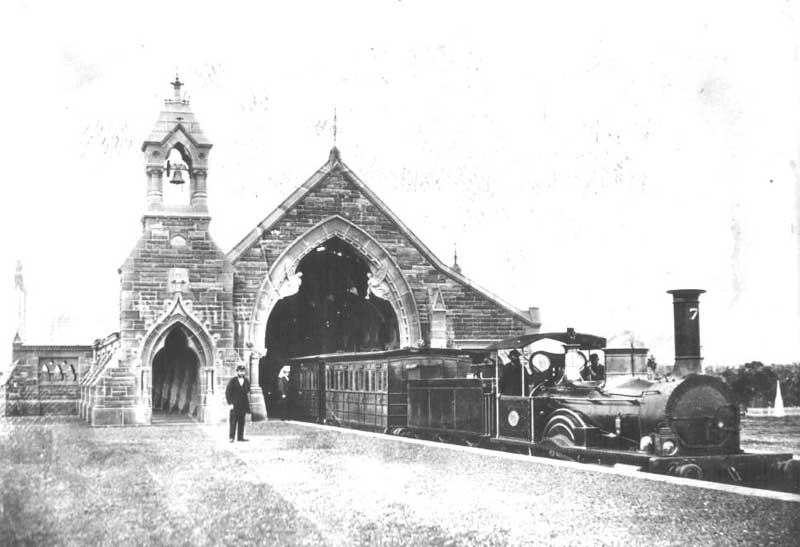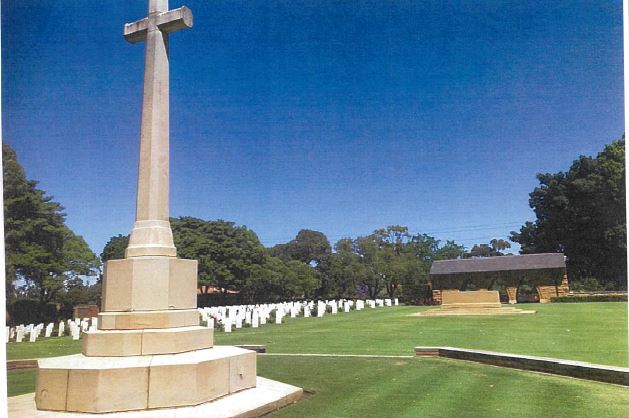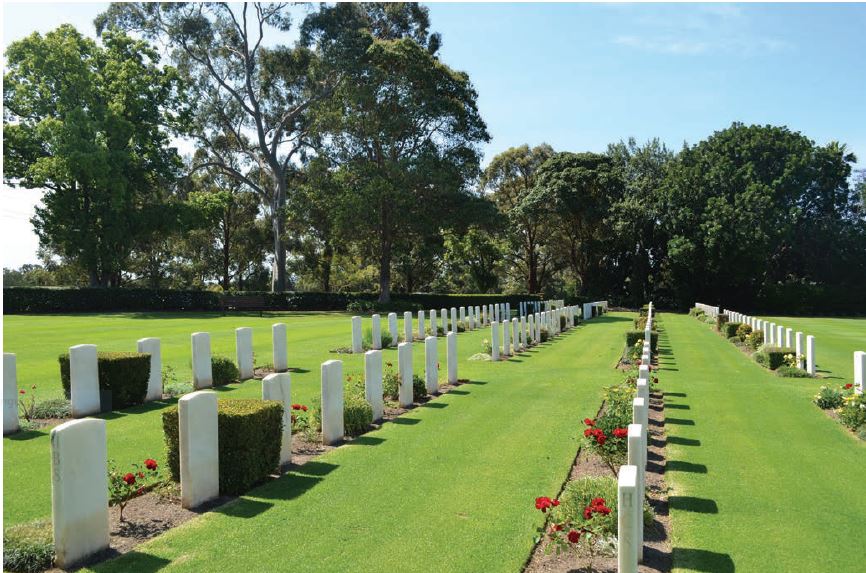- Author
- A.N. Other
- Subjects
- History - general
- Tags
-
- RAN Ships
- None noted.
- Publication
- December 2023 edition of the Naval Historical Review (all rights reserved)
By Mark Bundy
Thanks to Estelle Muspratt from the Office of Australian War Graves and Harry Johnston-Lord from the Friends of Rookwood, we have been able to provide the following information. Rookwood has over one million stories, some of which come from the War Cemetery.
The Beginnings
With an ever-expanding city, earlier burial grounds became full and the decision was made to create a new large cemetery to the west. With the advantage of new railway line to Parramatta a site was chosen not far from this line at the new and sparsely populated suburb of Rookwood about nine miles (14 km) from the CBD. The suburb’s name has since changed to Lidcombe, but the cemetery retained its original name of Rookwood.
Established on 1 July 1867, Rookwood General Cemetery is one of the largest in Australia. Overall, Rookwood covers 760 acres and now has over 1,000,000 people buried here and we are still conducting over 2000 burials plus cremations a year. We believe that we are the only cemetery that caters for 89 religions or beliefs. The first recorded burial was John Whalan, an 18-year-old pauper who had only been in the colony for a few months.
To assist with the transportation of funerals a branch line was built from near Sydney’s Central Station to Rookwood. With ornate departure and receiving stations, this opened in August 1869. Trains ran daily, leaving Sydney at 9.30 am and 3 pm which could deviate to pick up others en route. Specially designed wagons could take up to ten coffins and carriages with many mourners at a cost of one shilling per person, with the deceased riding free. After the interment picnics were held in the grounds while mourners awaited their return trains.
With the popularity of motor transport, trains ceased running in 1948 and the Receiving House Station at Rookwood was offered for sale. It was eventually bought for £100 by All Saints Church of England in Canberra and demolished. All the stones were numbered, transported to Canberra in 83 semi-trailer loads, and rebuilt. The splendid new All Saints Church Ainslie was dedicated in 1959.

Some notables who call Rookwood home include: John Gowing and David Jones (department stores), Bea Miles (well-known female eccentric), James Toohey (brewer), Peter Dodds McCormick (author of Advance Australia Fair), Louisa Lawson (suffragette and mother of Henry Lawson), Jack Lang and Joseph Cahill (Premiers of NSW) and John Fairfax (newspapers).
Prior to 2012 Rookwood was made up of many individual groups having their own offices, procedures and conditions. In April 2012, the New South Wales Government announced that Anglican, General, Independent, Jewish and Islamic burials would combine as the General Cemetery. And on 1 July 2023 Rookwood amal-gamated with Botany, Woronora, Macquarie Park, Gore Hill, Field of Mars, Frenchs Forest and Sandgate at Newcastle to form Metropolitan Memorial Parks. This was done with the view of economies to enable the purchase of new sites to meet the needs of the population. Rookwood will continue to operate as there is no limit to cremations. For new burials however, we believe that all the available space will be used in the next four to five years.
Old Army Anglican Section
Although the majority of burials are of members of the public, there are significant areas devoted to members of the armed services. One of these is called the Old Army Anglican section, commemorating participants from the Sudan Expedition of 1885 through to the Vietnam War. The first burial in this part of the cemetery was Bombardier Henry Palmer. Like so many of the earlier burials, he was of British origin, having emigrated from London to the colonies. Henry was serving with the NSW Artillery in 1888 when he died of tuberculosis in the hospital at Victoria Barracks.
Old Army has one of the largest concentrations of Vietnam War dead in Australia with 11 Vietnam War dead and two Vietnam veterans who died in Australia soon after their tours of duty. Some of these men were amongst the first Australian servicemen repatriated to Australia who had died in war. Prior to 1966, personnel who died while fighting overseas were buried in a war or military cemetery plot that was close to where they fell.
Among those who died in the Vietnam War was Warrant Officer Class Two (WO2) Ronald Scott. He was serving with the Australian Army Training Team Vietnam when he was fatally shot by a sniper in Quang Tin Province north of Saigon, in September 1965. His American comrade, Master Sergeant Eugene Jordon, kept a promise to WO2 Scott that he would be buried on Australian soil. He arranged for the Australian to be brought home for interment in the Old Army Anglican Section. The military funeral procession in Sydney was nearly a kilometre long, observed by shoppers and workers who bowed their heads. The following year the Australian Government changed its policy to enable repatriation to Australia, at Commonwealth expense, of all Australian Defence Force personnel who had died in war or on operations. This change was not retrospective.
The Sydney War Cemetery
The Sydney War Cemetery was established by military authorities in 1942. It contains mainly the graves of those who died in the Concord Military Hospital, either from wounds received in operational areas, or through sickness or accident while they were serving during the period of the Second World War. This cemetery was taken over by the Commonwealth War Graves Commission in December 1946 and contains 732 Commonwealth burials and commemorations of the Second World War. Australia is a member of the Commission and the Office of Australian War Graves is the Agent of theCommonwealth War Graves Commission in Australia, Papua New Guinea and the Solomon Islands.
The New South Wales Cremation Memorial is within the building which forms the entrance to Sydney War Cemetery and commemorates by name men who died in New South Wales during the Second World War and were cremated in various places throughout the State. Their ashes were either scattered or are buried where proper commemoration is not possible. There are, in all, 199 names on the memorial.
In the rear corner of the war cemetery is the Sydney Memorial. This commemorates almost 750 men and women of the Australian Army, Air Force and Navy who lost their lives during the Second World War in the eastern and southern regions of Australia, and adjacent waters south of 20 degrees latitude, and who have no known grave. It is interesting to note that Rookwood General Cemetery contains 393 First World War burials and 253 from the Second World War. Also, within Rookwood Crematorium, 127 servicemen of the Second World War, whose remains were cremated, are commemorated. Those members of the United Kingdom Forces who are buried in the cemetery died while prisoners of war in Japanese hands and were cremated. After the war, the Army Graves Service arranged for their ashes to be brought to Sydney by HMS Newfoundland for interment. Among the war graves is that of one civilian who died while in the employment of the Admiralty during the war. There is also one French war grave.

American Graves
There were 467 American servicemen who died in or near Australia during the Second World War who are buried at Rookwood. The Americans embalmed their dead and they were taken to Rookwood for interment. Post-war it was time to go home, and starting on 17 November 1947 the caskets were exhumed. Taking three days, this was carried out by locally hired labourers. The caskets were then moved under canvas covers by rail to Brisbane.
An American serviceman, the late USMC Major Roy Parker (Rtd), then living in Australia volunteered as the Honour Guard for the transport of the caskets to Brisbane where they were joined by 1406 American caskets exhumed from Ipswich Cemetery for loading on a ship, the USAT Goucher Victory. The ship sailed before Christmas bound for Guadalcanal where the caskets were unloaded to join 3346 caskets from Guadalcanal loaded onto USAT Cardinal O’Connell for transport to Hawaii. Families could then nominate where the remains were to be re-interred.
Central to the core principles of the Commonwealth War Graves Commission is equality. No one individual, regardless of race, rank, or creed, is more important than another. In death, those who serve and have fallen are equal. The staff of the Office of Australian War Graves is responsible for the care and maintenance of over 325,000 official commemorations for war dead and post-war dead around Australia including the Sydney War Cemetery and the New South Wales Garden of Remembrance.





